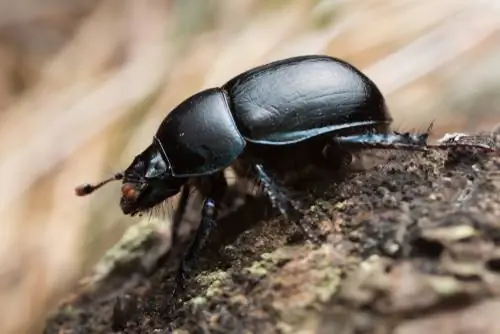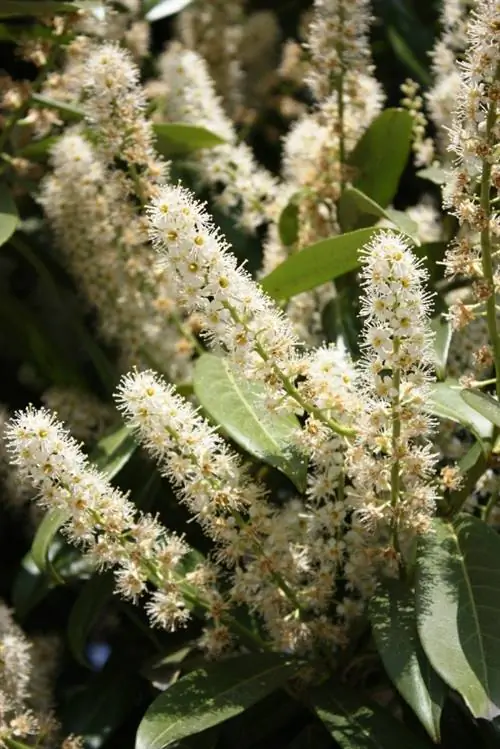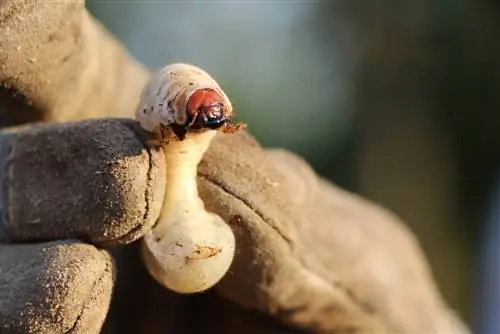- Author admin [email protected].
- Public 2023-12-26 14:17.
- Last modified 2025-01-23 11:22.
Hobby gardeners are amazed when they suddenly find a five centimeter beetle in the garden. There are different species that can reach such impressive heights. Some of them prefer to be close to humans. But only a few are harmful.
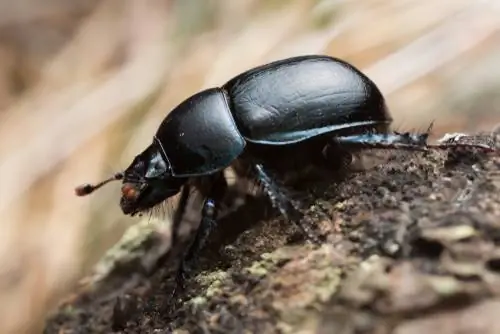
What big black beetles are there in the garden?
Large black beetle species in gardens include longhorn beetles, roaches, dung beetles and flour beetles. They vary in size, coloration and lifestyle, with some considered beneficial and others considered pests. Most prefer natural habitats and are often found in garden areas.
Common black beetles
There are numerous black beetles, but only a few are cultural followers and settle in human habitations. Many of them are not pests, but simply become a nuisance in large numbers. Depending on the species, the beetles reach a size of between 10 and 80 millimeters. Although many of these species are equipped with wings, they are rarely seen in flight.
longhorn beetle
Beetles with long antennae belong to the longhorn beetle family. Their antennae are longer than the body, which is usually elongated and flat in shape. Many species feed on flower parts, pollen or tree sap. Others eat fresh bark, leaves or stems of herbaceous plants and trees. However, the majority of longhorn beetle larvae feed on wood, with the condition of the wood playing an important role. Not every longhorned beetle is a wood pest, as many larvae only eat dead wood.
- Large oak beetle: black-brown, larvae eat heartwood of old oak trees
- Small oak beetle: solid black, larvae decompose wood of various deciduous trees
- House buck: brown to black, larvae eat dead coniferous wood and timber
Schröter
A black beetle with pincers is distinctive. This stag beetle is a successful cultural follower and, like the stag beetle, belongs to the Schröter family. Most species in this family are wingless when fully grown and no longer eat food. The feeding stage is formed by the larvae, which mainly live in dead wood. Some Schröter are attracted by artificial light sources and occasionally get lost in the apartment.
Profile:
- between eight millimeters and nine centimeters tall
- variable coloring: brick red, reddish brown or black
- Male often with conspicuous mouthparts

Dung beetle
These beetles are between ten and 45 millimeters long and can be dark brown, purple or black in color. Their bodies often have a metallic sheen. The forest dung beetle is a common species that crawls across the forest floor or can be found in the garden. In flight the animals appear clumsy. Since they feed on the dung of other animals, they are considered important decomposers in the natural ecosystem.
Excursus
Impressive orientation
The vine cutter (Lethrus apterus) is a dung beetle that belongs to the subfamily Lethrinae. It occurs in the extreme southeast of Central Europe and has amazed researchers. When the nocturnal beetles leave their breeding chamber to look for food sources, they orientate themselves by starlight. To do this, they stand on a dung ball and rotate on their own vertical axis. You remember the image of the night sky with its light sources like a snapshot.
Black Beetle
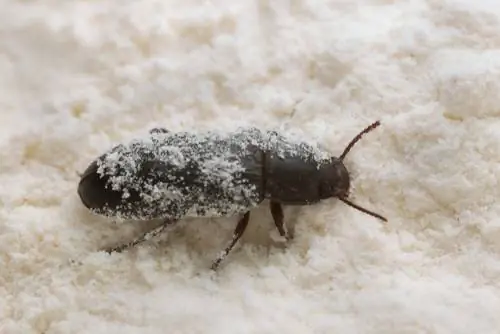
The flour beetle is often found in flour
A distant relative of roaches and dung beetles that can fly is the flour beetle. It belongs to the black beetle family, which prefers warm habitats and often acts as a cultural follower. Therefore, they are often found close to humans.
Black beetles are between one and 50 millimeters long and have a variable body structure. This makes them easily confused with other beetles. Most species are completely black or black-brown. There are beetles with rusty yellow or brown coloring.
| scientific | habitat | Food | Pest | Size | |
|---|---|---|---|---|---|
| Large death beetles | Blaps mortisaga | in dark places in cellars, barns and stables | decompose organic material | no | 2 to 3 cm |
| Flour Beetle | Tenebrio molitor | Mull, rotting wood and bird's nests, flour and grain | Insectivores, feed on starch | yes | 1 to 2 cm |
| Beam Schröter | Dorcus parallelipipedus | Deciduous forests and orchards with old trees | feed on tree sap | no | 1 to 3 cm |
| Stag Beetle | Lucanus cervus | warm open landscapes | suck plant juices | no | Male 3 to 8 cm, female 3 to 5 cm |
| Forest dung beetle | Anoplotrupes stercorosus | Beech forests, gardens | decomposes feces, eats mushrooms and sucks tree sap | no | 1 to 2 cm |
Flying black beetle in the garden?
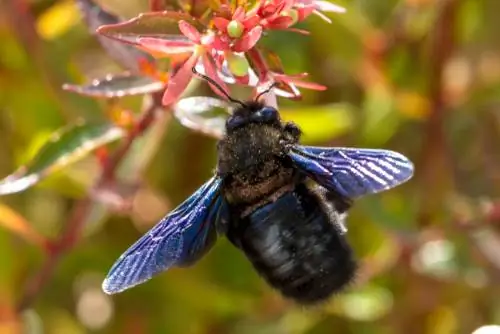
This “beetle” is the blue-black carpenter bee
The supposed beetle is often the blue-black carpenter bee, which is unmistakable with blue wings. It is the largest wild bee that you can observe in Germany. It comes out of its winter quarters in spring with the first warm rays of sunshine and looks for food on nectar-rich flowering plants.
What carpenter bees like:
- Ornamental sweet peas, honeysuckle and rosemary
- dead tree trunks
- sunlit places
Where the beetles can appear
Culture followers are animals that benefit from numerous advantages due to changes in the landscape caused by humans. They find better food sources, safe places to retreat and warm winter quarters. Therefore, these animals, like many black beetles, follow humans and settle in cultivated landscapes and in buildings.
Black beetles belong to different families and have different lifestyles. Their food spectrum is correspondingly diverse.
In the garden
Most species prefer varied habitats where plants, shrubs and trees provide food. Dead wood ensures a safe place to retreat and overwinter. In addition, many beetles lay their eggs in the rotten wood. Dark niches under piles of stones or wooden pallets are also often populated by various beetles.
Tip
With a garden that is close to nature and as diverse as possible, you can offer endangered species a habitat. Even small areas that are left to their own devices are enough.
In the house
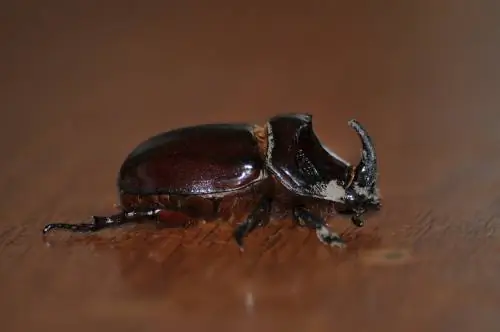
If you find a beetle at home, you should take it outside with great care and under no circumstances kill it
If you find a black beetle in your apartment, you shouldn't panic right away. Most species entered the building by chance through open windows because they were attracted to light sources.
Species like the large death beetle prefer dark and undisturbed areas such as cellars and barns. In nature they often live in burrows of various mammals. Wood-dwelling longhorn beetle larvae are difficult to detect. They usually have a development period of several years and are also rarely observed as adult insects in the house.
Fighting black beetles?
Before taking control measures, you should accurately identify the species. Not every beetle is considered a pest. Many insects are useful because they remove and decompose organic material and debris. Species identification is also important because not every black beetle becomes a pest but is subject to legal protection.
| specially protected | Frequency | ||||
|---|---|---|---|---|---|
| Large death beetles | no | still common, probably going back | |||
| Flour Beetle | no | one of the most common cultural followers | |||
| Beam Schröter | yes | not endangered | |||
| Stag Beetle | yes | Endangered | |||
| Forest dung beetle | no | often | |||
| Big oak buck | yes | critically endangered | |||
| Little Oak Bock | yes | common, declining sharply locally | |||
| Hausbock | no | often | |||
| Blue Black Carpenter Bee | no | common in warm regions |
Fighting black beetles
The flour beetle is becoming increasingly rare as a pest. The species can still reproduce well in buildings that were formerly used as storage facilities for grain. The beetles are extremely agile and look for suitable places in the home to lay their eggs. They hide in dark niches or between pipes under ceilings. Flour, spaghetti and bird seed are optimal food sources.
How to fight flour beetles:
- Cleaning cabinets and drawers
- vacuum the niches behind the stove and furniture
- Store vacuum cleaner bags in a sealed plastic bag
- dispose of contaminated food
- If infestation is suspected, food can be saved by freezing
Tip
Pheromone traps attract the beetles. It may be that this causes the crawlers to develop into a nuisance even more quickly.
Frequently asked questions
Are there big black beetles with blue wings?
Behind the supposed beetle with the striking wing coloring is the blue-black carpenter bee. It has little in common with beetles. The impressive insect is the largest native wild bee species. It can be seen foraging for food in spring. Nectar-rich flowering plants are optimal sources of energy.
What is the name of the big black beetle with pincers?
If you discover such a beetle in your garden, consider yourself lucky. You probably found a stag beetle. Only males develop these distinctive mouthparts. However, they no longer have any function because the animal cannot look after itself. The female helps the partner by enlarging wounds in the bark of oak trees. The beetles then suck up the escaping plant sap.
Which black beetles have long antennae?
Strikingly long antennae are typical of the longhorn beetle species. The antennae usually protrude beyond the size of the body, which makes these beetles unmistakable. However, their coloring is variable. Not every longhorned beetle is black. Most species are iridescently colored, with the color range ranging from blood red to blue to metallic green.
Which beetle native to Germany is the largest?
Beetles in Central Europe can grow between two millimeters and eight centimeters in size. Of the native beetle species, the stag beetle is the largest species. At three to five centimeters, the females are slightly smaller than the males. These grow up to eight centimeters long. This body size can exceed a species from the longhorned beetle family. At 17 centimeters, the giant longhorned beetle is the world's largest beetle species. However, this occurs in Brazil.
How can I distinguish black beetles?
View pictures on destination portals. Large beetles can be identified quite easily because they usually develop strikingly visible body characteristics. Body shape, antennae and elytra can be used to identify the family. To accurately identify the species, you may need to take a closer look at the leg limbs, pronotum or mouthparts.

